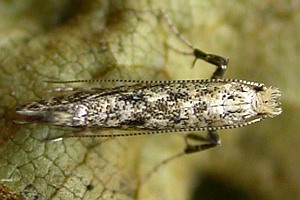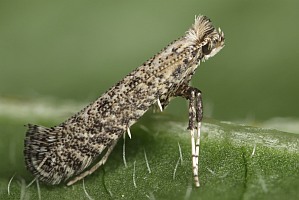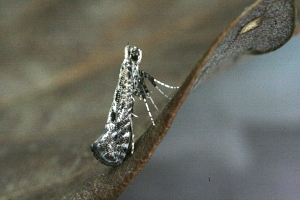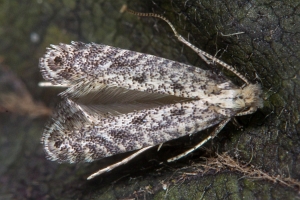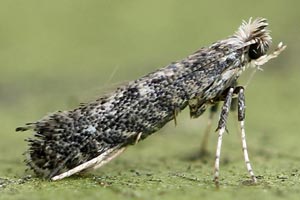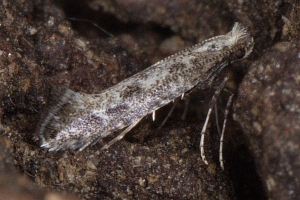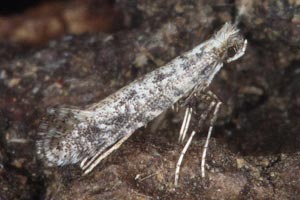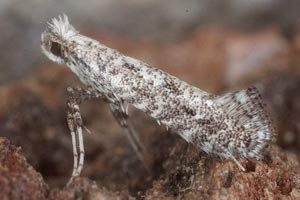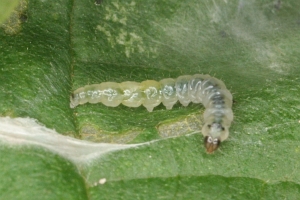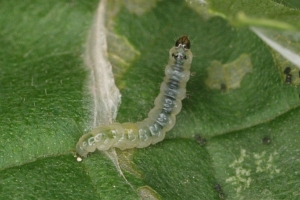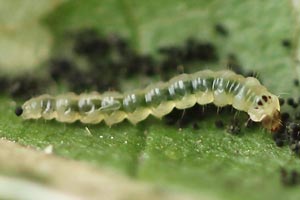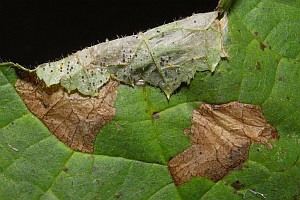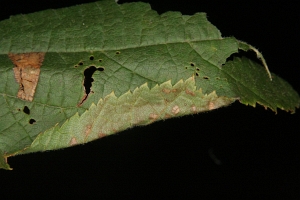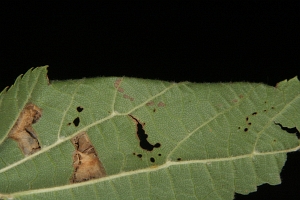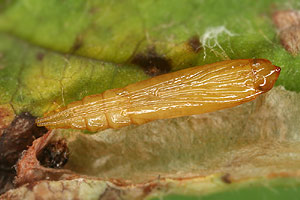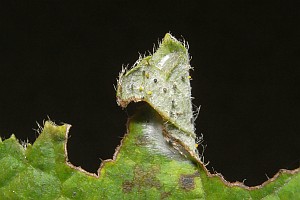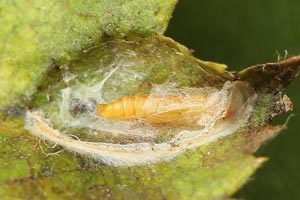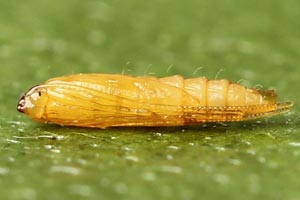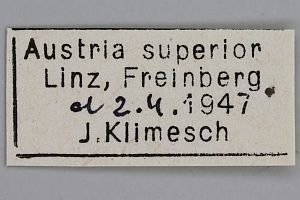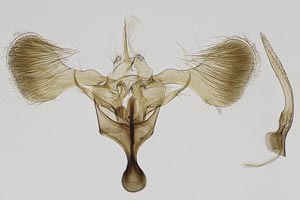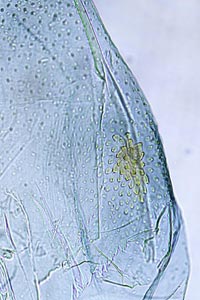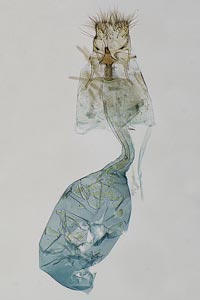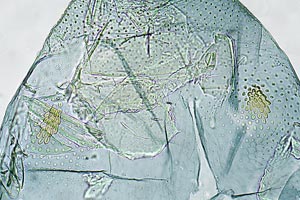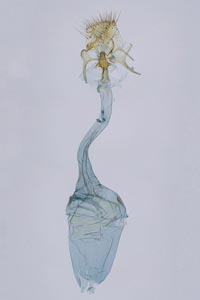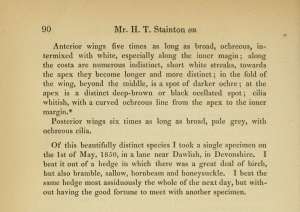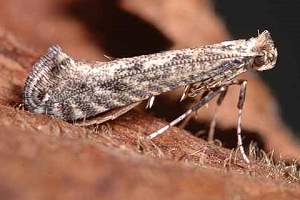


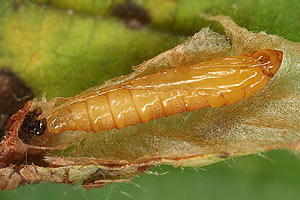
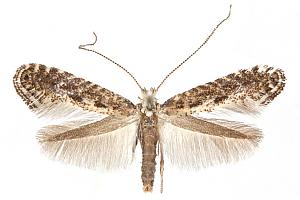
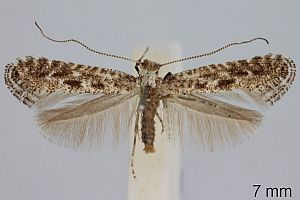
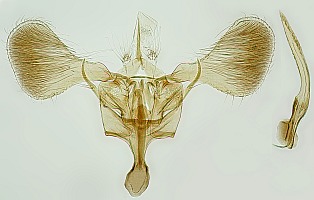
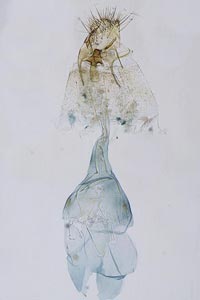
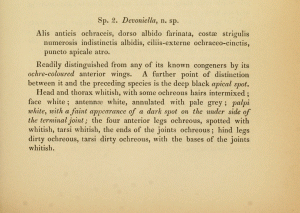
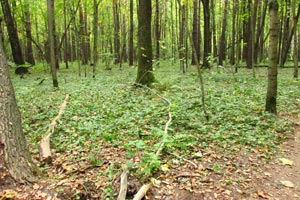
1. Lebendfotos
1.1. Falter
1.2. Raupe
1.3. Fraßspuren und Befallsbild
1.4. Puppe
2. Diagnose
2.1. Weibchen
2.2. Geschlecht nicht bestimmt
2.3. Genitalien
2.3.1. Männchen
2.3.2. Weibchen
2.4. Erstbeschreibung
3. Biologie
3.1. Habitat
3.2. Nahrung der Raupe
- [Betulaceae:] Corylus avellana (Gemeine Hasel)
- [Betulaceae:] Corylus colurna (Baum-Hasel)
- [Betulaceae:] Corylus maxima (Lambertshasel)
- [Rosaceae:] Cotoneaster sp. (Zwergmispel)
Die Raupe wird in aller Regel an Haseln (Gattung Corylus, Betulaceae) gefunden. Es gibt aber zumindest eine plausible Angabe zu Zwergmispeln (Cotoneaster, ein Sprung, den es auch bei anderen Gracillariidae gibt).
(Autor: Erwin Rennwald)
4. Weitere Informationen
4.1. Andere Kombinationen
- Ornix devoniella Stainton, 1850 [Originalkombination]
4.2. Synonyme
- Parornix avellanella (Stainton, 1854)
- Parornix cotoneastri (Caradja, 1920)
4.3. Taxonomie
Lopez-Vaamonde et al. (2021, supplementary material) erläutern in ihrer Checklist zu Parornix avellanella (Stainton, 1854): "A junior subjective synonym of Parornix devoniella (Stainton, 1850) (see: Meyrick 1927). Kuznetsov and Baryshnikova (2003) treated Parornix avellanella as the valid name for the Corylus-feeder; furthermore they synonymized P. betulae (Stainton, 1854), the Betula-feeder, with Parornix devoniella, the Corylus-feeder, following the note by Pierce and Metcalfe (1935) who wrote that the type of P. devoniella is P. betulae. Here we prefer to keep P. avellanella as a junior synonym of P. devoniella and we list P. devoniella and P. betulae as the valid names in the verified checklist until more research is done on the identity of the name devoniella."
4.4. Faunistik
Die Art wurde aus England bescherieben, galt aber bald als in Europa weit verbreitet. Laštůvka & Laštůvka (2014: 635) melden sie erstmals für Spanien und kommentieren: "ES: Gerona, Espinelves, 1 ♂, 27-VI-2012; León, Páramo de Sil, 1 ♂, 1 ♀, 19-VI-2014. Widespread in Palaearctic region, with trophic relation to Corylus avellana (DE PRINS & DE PRINS, 2005, 2014). Known from some provinces in Portugal: Estremadura (CORLEY et al., 2006), Douro Litoral and Trás-os-Montes (CORLEY et al., 2009) and Beira Baixa (Laštůvka & Laštůvka, 2009). New species for Spain (Figs. 14-16)."
4.5. Literatur
- Laštůvka, A. & Z. Laštůvka (2014): New records of mining moths from the Iberian Peninsula from 2014 (Insecta: Lepidoptera). — SHILAP Revista de Lepidopterología, 42 (168): 633-647. [PDF auf redalyc.org]
- Lopez-Vaamonde, C., Kirichenko, N., Cama, A., Doorenweerd, C., Godfray, H.C.J., Guiguet, A., Gomboc, S., Huemer, P., Landry, J.-F., Laštůvka, A., Laštůvka, Z., Lee, K.M., Lees, D.C., Mutanen, M., van Nieukerken, E.J., Segerer, A.H., Triberti, P., Wieser, C. & R. Rougerie (2021): Evaluating DNA Barcoding for Species Identification and Discovery in European Gracillariid Moths. — Frontiers in Ecology and Evolution, 9 (Artikel 626752): 1-16.[ [https://www.frontiersin.org/articles/10.3389/fevo.2021.626752/full] zum open-access-Artikel auf frontiersin.org]
- [SCHÜTZE (1931): 59]
- Erstbeschreibung: Stainton, H. T. (1850): On Ornix Meleagripennella and its Allies; a Group of Lepidoptera, Family Tineidae. — The Transactions of the Entomological Society of London. 2 (1): 86-96.
- Stainton, H. T. (1864): The natural history of the Tineina 8: I-IX, 1-315, Gracilaria pl. I-V, Ornix pl. I-III. London (John van Voorst) – Paris (Deyrolle) – Berlin (E. S. Mittler und Sohn). — Digitalisat auf archive.org: [280-291], [Ornix pl. III fig. 1] (unter dem Namen Ornix avellanella).



![Vorkommen in Österreich [Huemer (2013: NR 0627)]](/res/img/flag/at.png)
![Vorkommen in Norwegen (außer Spitzbergen und Jan Mayen) [Aarvik & al. (2017): Nordic-Baltic Checklist]](/res/img/flag/no.gif)
![Vorkommen in Dänemark (außer Färöer-Inseln und Grönland) [Aarvik & al. (2017): Nordic-Baltic Checklist]](/res/img/flag/dk.gif)
![Vorkommen in Schweden [Aarvik & al. (2017): Nordic-Baltic Checklist]](/res/img/flag/se.gif)
![Vorkommen in Finnland (außer Åland-Inseln) [Aarvik & al. (2017): Nordic-Baltic Checklist]](/res/img/flag/fi.gif)

![Vorkommen in Russland (europäischer Teil bis Manytsch-Niederung) [Kozlov, Kullberg & Zverev (2014)]](/res/img/flag/ru.gif)
![Vorkommen in Weißrussland [Pisanenko, A., Švitra, G. & V. Piskunov (2019): Checklist of Lepidoptera recorded from Belarus]](/res/img/flag/by.gif)
![Vorkommen in Estland [Aarvik & al. (2017): Nordic-Baltic Checklist]](/res/img/flag/ee.gif)
![Vorkommen in Lettland [Aarvik & al. (2017): Nordic-Baltic Checklist]](/res/img/flag/lv.gif)
![Vorkommen in Litauen [Aarvik & al. (2017): Nordic-Baltic Checklist]](/res/img/flag/lt.gif)
![Vorkommen in Polen [Buszko J. & J. Nowacki [eds] (2017): A Distributional Checklist of the Lepidoptera of Poland]](/res/img/flag/pl.gif)
![Vorkommen in Tschechien [Laštůvka, Z. & J. Liška (2011): Komentovaný seznam motýlů České republiky]](/res/img/flag/cz.gif)

![Vorkommen in Ungarn [Pastorális et. al. (2018): A Magyarországon előforduló molylepke-fajok névjegyzéke]](/res/img/flag/hu.gif)
![Vorkommen in Großbritannien [Agassiz, Beavan & Heckford (2013): Checklist of the Lepidoptera of the British Isles]](/res/img/flag/gb.gif)
![Vorkommen in Irland einschließlich Nordirland [Bond & O'Connor (2012): Checklist of Irish Species]](/res/img/flag/ie.gif)
![Vorkommen in Belgien [De Prins(2016): Catalogus van de Belgische Lepidoptera]](/res/img/flag/be.gif)
![Vorkommen in den Niederlanden [Kuchlein & de Vos (1999): Annotated Checklist of the Dutch Lepidoptera]](/res/img/flag/nl.gif)
![Vorkommen in Luxemburg [Hellers (2017): Roeslerstammiidae - Graciallariidae]](/res/img/flag/lu.gif)
![Vorkommen in Frankreich (europäisches Territorium ohne Korsika) [Vandromme et al. (2020): Liste systématique et taxinomique des Lépidoptères de France]](/res/img/flag/fr.gif)
![Vorkommen in Spanien (Festland) [Vives Moreno A. (2014)]](/res/img/flag/es.gif)
![Vorkommen in Portugal (Festland) [Corley (2015): Lepidoptera of Continental Portugal]](/res/img/flag/pt.gif)
![Vorkommen in Italien (Festland und kleine festlandsnahe Inseln) [Gaedike et al. (1995): Checklist delle Specie della Fauna Italiana 81]](/res/img/flag/it.gif)
![Vorkommen in Slowenien [Lesar & Govedič (2010): Check list of Slovenian Microlepidoptera]](/res/img/flag/si.gif)
![Vorkommen in Kroatien [Matošević & al. (2013): Research of leafminers on woody plants in Croatia]](/res/img/flag/hr.gif)
![Vorkommen in Serbien [Jakšić (2016): Tentative Checklist of Serbian microlepidoptera]](/res/img/flag/rs.gif)
![Vorkommen in Rumänien [Rákosy L. & M. Goia (2021): Lepidopterle din România: lista sistematică şi distribuţie]](/res/img/flag/ro.gif)
![Vorkommen in Bulgarien [Buszko & Beshkov (2004): A preliminary survey of leafmining moths of the Bulgarian part of Eastern Rhodopes]](/res/img/flag/bg.gif)
![Vorkommen im europäischen und/oder asiatischen Teil der Türkei [Koçak & Kemal (2018) ohne Angabe einer Provinz]](/res/img/flag/tr.gif)



